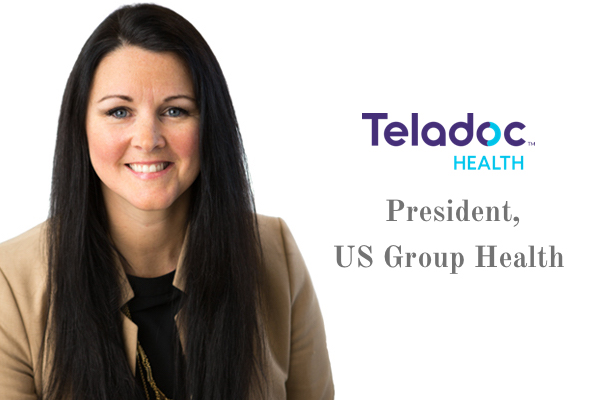
Kelly Bliss
President, U.S Group Health
Kelly Bliss is president of U.S. Group Health. She brings to table a vast experience and expertise in creating cohesive client-focused organizations. At Teladoc Health, she has been instrumental in taking client services to record highs. Previously, she had been associated with Best Doctors and InterSystems. Recently, Bliss featured in The Healthcare Technology Report’s Top 25 Women Leaders in Healthcare Software of 2020.
Hiral: Kelly, thank you for taking time out of your busy schedule to talk with us. DistilINFO appreciates it!
To start with, tell us about yourself, your career journey so far and your current role at Company. What are the key traits that made you successful in your roles?
Kelly: I currently serve as President of U.S. Group Health at Teladoc Health where I oversee our growth and execution for B2B2C markets including Employer, Health Plan, TPA and Government business where we bring our company’s full suite of solutions to support end to end client strategy.I joined Teladoc Health in 2017 through the acquisition of Best Doctors, where I served as chief of staff, leading the organization’s key strategic growth initiatives.
I have spent my entire career in healthcare, from healthcare design to health technology, and now to this new category of whole-person virtual care which, of course, is the most exciting space to be in. I am super passionate about creating high performing teams and driving hyper growth, so I have certainly landed in the right spot.
Hiral: The merger between Teladoc Health and Livongo was the biggest one amid the prevailing pandemic. How has this helped Teladoc Health and what does it mean for your clients?
Kelly: The combination of clinical solutions with data and artificial intelligence has truly opened the minds of healthcare ecosystem to the potential of virtual care. We had our sights set on bringing clinical depth and breadth with Teladoc Health, and now, with Livongo and chronic disease management, we have shaped the next generation of virtual care. We are truly the only partner to span a person’s entire healthcare journey.
For our clients, we’re not only providing a unified experience for members, but better outcomes as we take the data gathered across millions of health journeys and turn it into actionable insights for members and clinicians. The combined capabilities not only deliver and empower member care, but also have the flexibility to empower our health plan partners by reducing costs, improving clinical quality at scale, and removing waste by integrating and coordinating care virtually.
Hiral: The pandemic has no doubt accelerated the adoption of telehealth. What does the future hold for this technology?
Kelly: There is a difference between transforming health care and putting doctors on a screen.
We see an amazing opportunity to use virtual care in a way that goes beyond just treating the sick, which is still critically important, and move to helping people live healthier lives. There will be a notable shift from episodic care to longitudinal or multidimensional care where virtual care essentially acts as the ‘digital front door’ to the rest of the healthcare ecosystem.
We can build a complete understanding of each person, using whole-person data, advanced insights, and predictive analytics. By bringing together both novel and traditional data, care providers can reference a whole-person view of an individual that evolves as their health journey changes in real time. This level of personalization plays a valuable role in connecting people to the interventions that are most useful and most relevant to them at the right time.
Hiral: How are health plans leveraging technology to build a better member experience?
Kelly: Consumer expectations have changed. Those who leveraged virtual care during the pandemic have started to understand and appreciate that a better way of accessing and managing healthcare does exist. And more than just access and connectivity, we know consumers are more inclined now than ever to view their health holistically.
One of the best ways for health plans to deliver this expectation is with virtual primary care. Historically, primary care has been centered around the annual wellness exam, but those visits aren’t always conducive of a good consumer experience, and still, despite the ongoing nature of the visit, can lead to gaps in care over time.
Virtual primary care not only removes the common barriers associated with in-person visits but gives members everything they need to build a health-focused longitudinal relationship with their primary care doctor. It leverages the top technology assets available and uses data at scale to deliver the best care possible, and in the unified experience consumers so often crave.
Hiral: Any closing thoughts you would like to share with our readers?
Kelly: Health plans are taking stock and inventory of their virtual care strategy: where it’s been, how it has performed and how it can evolve. And you can’t ignore the consumer.
Health plans need a way to look at a member population over a longer period of time and leverage virtual care in a way that will impact the cost trend. In the end, virtual care is paramount for health plans to deliver, enable and empower integrated whole person care that spans the full healthcare journey at any location possible.

